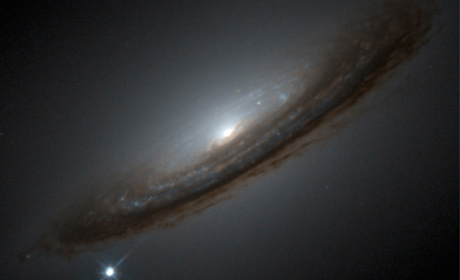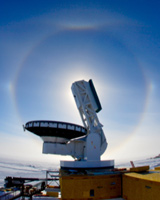International Conference: The Dark Universe
27 September 2011

© NASA, Hubble Space Telescope
The Collaborative Research Centre/Transregio “The Dark Universe” of Heidelberg University and the universities of Bonn and Munich will hold an international conference from 4 to 7 October 2011. The conference will bring approximately 150 participants to Heidelberg to discuss research into dark matter and dark energy. Over the course of the event, world-renowned scientists will report their latest theoretical, observational and simulation findings.
Deciphering dark matter and dark energy, which together amount to over 95% of the energy density of our universe, is a chief goal of modern theoretical and experimental physics. A wealth of new data has enabled experts to draw indirect conclusions about dark matter. “Dark matter makes up one quarter of the energy density of our universe, but its physical nature and composition are unknown so far,” says Prof. Dr. Christof Wetterich of the Institute for Theoretical Physics at Heidelberg University and spokesperson of the “The Dark Universe” research centre.

The energy density of our universe also consists of dark energy evenly spread throughout space, Prof. Wetterich explains. “From recordings of the light of distant star explosions and other observation results, we can deduce that the expansion of the universe currently accelerates, a fact that can be traced back to dark energy.” The Heidelberg scientist says that the answer to the question of whether dark energy is static or dynamic has immense importance for physics, because it impacts astrophysics and cosmology as well as particle physics.
The upcoming conference in Heidelberg is devoted to presenting the findings of current research efforts in these areas. Participants will also discuss the work being performed by the Collaborative Research Centre/Transregio, which builds upon and develops research underway at the partner universities, Heidelberg, Bonn and Munich. As Prof. Wetterich explains, it is especially important that not only new theoretical developments are being presented, but also new observations permitting scientists to determine the amount of dark energy as a function of time, or shedding light on the question of whether dark matter and dark energy share a joint origin. Researchers from the Max Planck Institutes for Astrophysics and Extraterrestrial Physics in Munich are also collaborating on the eighteen projects that make up the “The Dark Universe”, which will continue until the middle of 2014 with a second round of funding by the German Research Foundation, roughly 10 million Euros.
This major international conference is part of the jubilee year events marking Heidelberg University’s 625th anniversary. As part of the conference programme, Prof. Wetterich will give a public address in which he will discuss the “big questions” of cosmology. This event, also titled “The Dark Universe,” will take place on Wednesday, 5 October 2011, at 8 p.m. in the Great Hall of the New University. Further information about the conference can be found at http://www.darkuniverse.uni-hd.de.
Note for newsdesks:
The conference will take place in the New University.
Contact:
Dr. Georg Wolschin
Institute for Theoretical Physics
Phone +49 6221 54-9415, or 54-9444
wolschin@uni-hd.de
Communications and Marketing
Press Office
phone: +49 6221 542311
presse@rektorat.uni-heidelberg.de

